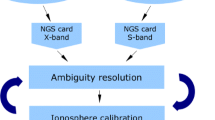Abstract
A dedicated 24 h S/X dual-band geodetic very long baseline interferometry (VLBI) experiment was conducted in January 2015 with the goal of improving the position estimates for the Chinese Deep Space Station Kashi. Previously, the position estimates had been only accurate to ~20 cm, which is insufficient for future Chinese deep space explorations. The experiment design and data reduction are described with special emphasis on the limited frequency ranges of Kashi for bandwidth synthesis. A narrowed multi-band delay search window based on post-fit residuals was utilized to resolve the sub-ambiguities due to the drop of a frequency channel in fringe fit, which saved ~22% of the observations from the affected baseline. Final position estimates of Kashi were obtained from the global solution by using more than 5300 international VLBI sessions from August 1979 to September 2015, and estimates were found to be accurate to about 10, 25, and 20 mm in the X, Y, and Z components. Various statistical tests were run, and the estimates and precisions are believed to be reliable.
Similar content being viewed by others
References
Yan J G, Ping J S, Li F, et al. Chang’E-1 precision orbit determination and lunar gravity field solution. Adv Space Res, 2010, 46: 50–57
Li P J, Hu X G, Huang Y, et al. Orbit determination for Chang’E-2 lunar probe and evaluation of lunar gravity models. Sci China Phys Mech Astron, 2012, 55: 514–522
Huang Y, Chang S Q, Li P J, et al. Orbit determination of Chang’E-3 and positioning of the lander and the rover. Chin Sci Bull, 2014, 59: 3858–3867
Liu Q H, Zheng X, Huang Y, et al. Monitoring motion and measuring relative position of the Chang’E-3 rover. Radio Sci, 2014, 49: 1080–1086
Zhou H, Li H T, Dong G L. Relative position determination between Chang’E-3 lander and rover using in-beam phase referencing. Sci China Inf Sci, 2015, 58: 092201
Zhou H, Xu D Z, Chen S W, et al. New high-accuracy spacecraft VLBI tracking using high data-rate signal: A demonstration with Chang’E-3. Sci China Tech Sci, 2016, 59: 558–564
Fan M, Hu X G, Dong G L, et al. Orbit improvement for Chang’E-5T lunar returning probe with GNSS technique. Adv Space Res, 2015, 56: 2473–2482
Li J L, Guo L, Zhang B. The Chinese VLBI network and its astrometric role. In: Jin W J, Platais I, Perryman M A C, eds. Proceedings IAU Symposium No. 248, 2007. 182–185
Zhou H, Li H T, Xu D Z, et al. Ground-based real-time tracking and traverse recovery of China’s first lunar rover. Adv Space Res, 2016, 57: 880–888
Martin-Mur T J, Kruizinga G L, Burkhart P D, et al. Mars Science Laboratory navigation results. In: Proceedings of the 23rd International Symposium on Space Flight Dynamics, Pasadena, 2012
Petrov L, Gordon D, Gipson J, et al. Precise geodesy with the very long baseline array. J Geod, 2009, 83: 859–876
Li J L, Xiong F W, Yu C L, et al. Precise determination of the reference point coordinates of Shanghai Tianma 65-m radio telescope. Chin Sci Bull, 2014, 59: 2558–2567
Sovers O J, Fanselow J L, Jacobs C S. Astrometry and geodesy with radio interferometry: experiments, models, results. Rev Mod Phys, 1998, 70: 1393–1454
Schuh H, Behrend D. VLBI: a fascinating technique for geodesy and astrometry. J Geodyn, 2012, 61: 68–80
Petrov L, Phillips C, Tzioumis T, et al. First geodetic observations using new VLBI stations ASKAP-29 and WARK12M. Publ Astron Soc Aust, 2011, 28: 107–116
Rogers A E. Very long baseline interferometry with large effective bandwidth for phase-delay measurements. Radio Sci, 1970, 5: 1239–1247
Wietfeldt J R D. A frequency-agile system for VLBI bandwidth synthesis. Dissertation for the Doctoral Degree. Toronto: York University, 1995
Gorham P W. Designing Optimal Bandwidth Synthesis Arrays for VLBI. The Telecommunications and Mission Operations Progress Report 42-133, NASA. 1998
Gipson J. An introduction to Sked. In: Proceedings of the 6th IVS General Meeting, Hobart, 2010. 77–84
Deller A T, Tingay S J, Bailes M, et al. DiFX: a software correlator for very long baseline interferometry using multiprocessor computing environments. Publ Astron Soc Pac, 2007, 119: 318–336
Tingay S J, Alef W, Graham D, et al. Geodetic VLBI correlation in software. J Geod, 2009, 83: 1061–1069
Shu F C, Zheng W M, Chen Z. Shanghai VLBI Correlator. In: International VLBI Service for Geodesy and Astrometry 2012 Annual Report, Greenbelt, 2013. 324–326
Jiang W, Shu F C, Tong F X, et al. Recent Geodetic Activities of the Shanghai VLBI Correlator. In: Proceedings of the 8th IVS General Meeting, Shanghai, 2014. 224–227
Cooper B F C. Correlators with two-bit quantization. Aust J Phys, 1970, 23: 521–527
Altamimi Z, Collilieux X, Métivier L. ITRF2008: an improved solution of the international terrestrial reference frame. J Geod, 2011, 85: 457–473
Ma C, Arias E F, Bianco G, et al. The second realization of the international celestial reference frame by very long baseline interferometry. IERS Technical Note 35. 2009
Author information
Authors and Affiliations
Corresponding author
Rights and permissions
About this article
Cite this article
Xu, D., Dong, G., Zhou, H. et al. Improved position estimates for the Chinese Deep Space Station Kashi derived by geodetic very long baseline interferometry. Sci. China Technol. Sci. 59, 1346–1351 (2016). https://doi.org/10.1007/s11431-016-6089-z
Received:
Accepted:
Published:
Issue Date:
DOI: https://doi.org/10.1007/s11431-016-6089-z




